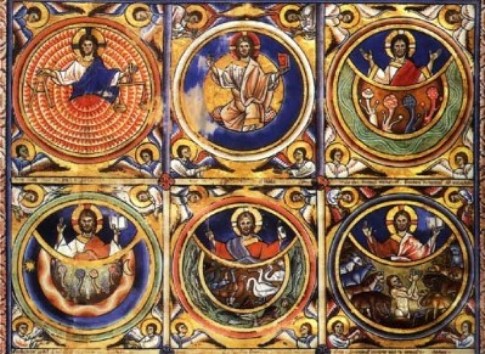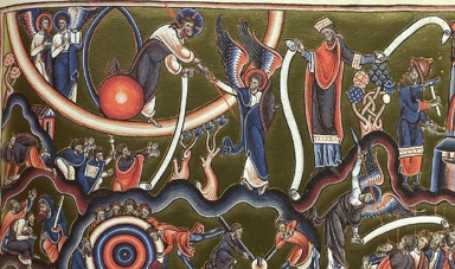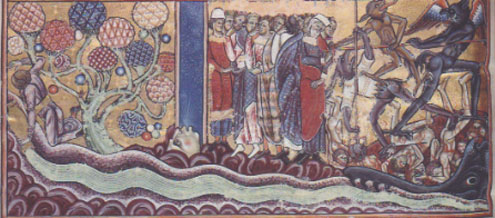The Discovery of a Lifetime

illustrating Biblical scenes with psychoactive mushrooms
In November 2006, shortly after the publication of my book Not in His Image, where I describe entheogenic rites in the pagan Mysteries at Eleusis and elsewhere, I made a long-awaited visit to the National Library in Paris. Upon acquiring a membership card I was able to consult the archives for Greek and Latin manuscripts, of which the BNF (Bibliotheque National de France) has an impressive collection. I was in quest of a very particular item, Latin MS 8846, the Paris Eadwine Psalter. This is the single and unique illuminated MS of the 12th century, the only one of its kind in the world.
I was not able to handle the actual MS, but I examined the color microfilm made from it. My session of three hours in the microfilm booth left me with wide eyes, a slack jaw, and unsteady feet. I literally staggered out into the Rue de Richelieu. For rest of the evening I remained in state of astonishment, totally stunned by the images I had seen rolling across the microfilm screen.
Psychedelic Bible
The Paris Eadwine Psalter is an oversize bound book of about 184 sheets, about 367 pages counting both sides. The cover page is stamped Volume No. 174, 10 October 1873, presumably the day it was acquired or catalogued. It opens with five full-page panels divided into twelve sections, lavishly colored and detailed. The panels show incidents from the Old Testament, running from the creation of Adam and Eve to the life of the Patriarch Jacob. There immediately follow many half-page and full-page illustrations of the Psalms interspersed with Latin commentary. After about 100 pages come four more twelve-section panels resuming the story of Jacob, then the illustrations jump to the Ark of the Covenant, David and Goliath, and John the Baptist. About 45 pages further on there is a unique page composed of eighteen panels celebrating Jesus Christ, followed by two more twelve-panel pages illustrating events in the life of the Savior.
All this is totally Biblical narrative, larded with pious commentary and directions for song and prayer. The Eadwine MS is after all a psalter, intended for use by a choir or congregation in reciting prayers.
What is far from routine, however, is the way the book is illustrated. Blue-staining mushrooms and mushroom-like omphali occur in lavish form in the first 100 pages. Dozens of pages display versions of a stylized tree with a blue trunk, depicting how psychoactive mushrooms grow from the trunk of a single "fruiting body" that sprouts from the mycelium. Often the mushroom trees are integrated into dramatic scenes showing humans interacting with angels and demons.

Some elaborate scenes depict Apocalyptic events with the figure of Christ often placed next to a huge mushroom cluster. The intertwining stems of the fungi, realistically shown as slender and curvaceous, just as they appear in the wild, are artistically woven in the Celtic style of the Book of Kells and other Irish illuminated manuscripts from the same era. In many scenes (see below), a naturalistic mushroom nestles among ornate omphalos-buds that recall the segmentation of raspberries and blackberries, yet these latter forms are clearly not naturalistic. They are carefully painted ovals or egg-shapes, distinct from the slender pin-headed mushrooms without segmented heads. Clearly, the artist knew the difference between stylistic and naturalistic representation and quite intentionally chose to juxtapose the two. I suggest that the omphalos-bud was an artistic convention of the Mysteries intended to indicate how molecular structure looks in the visionary trance induced by psychoactive plants.

There is considerable confusion about the naming of Latin MS 8846, called the Anglo-Catalan Psalter. Because it was made in Canterbury, England, around 1180 CE, it is sometimes called the Canterbury Psalter. It was left unfinished and taken to Spain for completion, hence the odd name Anglo-Catalan.
At the time of its construction, another, nearly identical psalter was produced in Canterbury: MS R 17.1 (987), kept at Trinity College, Cambridge, England. Both psalters are attributed to the master scribe named Eadwine ("generous friend"), and both contain the same sequence of narrative events, but the Canterbury psalter MS R 17.1 displays none of the entheogenic imagery of BNF Latin MS 8846, the Paris Eadwine Psalter. In 1935 M. R. James published a reduced fascimile of the Cambridge MS. More recently, in 1992, it has been published as The Eadwine Psalter by the Modern Humanities Research Association of Pennsylvania State University in the USA. This book can be ordered on Amazon.com for a heady price. Disappointingly, it shows that the Cambridge MS is totally devoid of psychoactive mushroom imagery.
In a chapter of the 1992 facsimile book, religious scholar Patricia Stirneman discusses the relationship of Latin MS 8846 to its Canterbury counterpart. Amazingly, she does not allude in any way to the lavish mycological imagery of the Paris MS; nor does she explain how two manuscripts produced from the same source at the same time could be so utterly different in visual presentation.
To scholars, the presence of psychoactive mushrooms in religious art is a closed subject, a revelation too outrageous to admit; but for this self-taught scholar it was the discovery of a lifetime.
Intentional Blindness
In 2002 the Spanish publishing house Moleiro publlished an exact copy of the Paris Eadwine Psalter, including the natural blemishes of the original pages. (The only earlier facsimile edition was published in Copenhagen in 1958.) The meticulous catalogue description makes not the slightest allusion to mushroom imagery, or anything at all unusual in the illustrations of the MS. The sample pictures offered by Moleiro are carefully cropped to avoid showing any evidence of offensive fungi. Another on-line resource, Facsimiles of Manuscripts Illuminated in the British Isles, reproduces some tell-tale scenes but without comment on what is being shown. An article on the Moleiro edition in the UK online magazine Church Times (July, 2005) says:
THE PSALTER, also known as the Anglo-Catalan Psalter, was made in Canterbury in about 1180. It was left unfinished, and, after 1200, was taken to Catalonia—perhaps as a gift. In the middle of the 14th century, the decoration of the manuscript was completed by Catalan artists, probably working in Barcelona.
The book was meant to be a copy of a famous Carolingian ninth-century Psalter, the Utrecht Psalter, and was acquired by the Christ Church Cathedral Priory, Canterbury, in about 1000. The original was named after the city to whose university library it now belongs, and was made at the Benedictine abbey of Hautvillers, near Rheims, between 820 and 835. Each psalm is illustrated by drawings with an attempt to depict certain passages in the text, and by amalgamating a number of scenes into a single rectangular picture.
The article loosely associates the BNF Latin MS 8846, the Anglo-Catalan Psalter loaded with mycological imagery, with the mushroomless Canterbury Psalter. Both originated in the area of Cambridge around 1120 CE, but only the latter remains in that town "to whose university library it now belongs." It explains correctly that the psalter kept in Cambridge, the one without mushrooms, was made first, and then came
the Great Canterbury Psalter, or the Anglo-Catalan Psalter, which followed all the innovations of the Eadwine Psalter. It has three parallel texts—Latin, Hebrew and Catalan—and also has the prefatory illustrations of the Old and New Testament scenes. To an extent, it is a copy of the Eadwine Psalter, particularly in its text, but the artists of the illustrations seem, on occasion, to have referred back to the original Utrecht Psalter of the ninth century.
This commentary is both both confused and confusing. The Anglo-Catalan Psalter is MS 8846 in Paris: this is certain because it is the one that was begun in England and completed in Spain, in Catalonia. It is a copy of the British Eadwine psalter, yes, if that came first, but quite different in respect to its illustrations. Up to about page 100, the Paris Eadwine MS is loaded with mycological imagery, but after that there is none. This suggests that the mushroom illustrations were done in England when work on the MS started, but not continued when it was finished in Spain. The expert commentary notes that the Canterbury illustrations (of both MSs, presumably) were based on the Utrecht Psalter, which displays the vivid image of a mushroom tree in the Garden of Eden, but makes no mention of that detail. Failure of attention or intentional blindness? Disregarding the blatant differences in illustration in the two Canterbury Psalters, scholars tend to confuse the two MSs.
As I noted elsewhere, the Wassons knew of the mushroom imagery of the Utrecht Psalter (Rheims, c. 800 CE) —knowledge that might have, but did not, lead them to discover the Paris MS.
The article continues:
A decision was made to alter radically the appearance of the illustrations by changing the monochrome or coloured drawings of the Utrecht and Eadwine Psalters to coloured paintings with larger figures and burnished-gold grounds—the technique used for the most luxuriously illustrated books of the late 12th century. This new style of illustration required the artists to make many innovations in the visual composition of their imagery. Of all the copies of the Utrecht Psalter, this one made the greatest demand on the creative ingenuity of its artists.
In spite of the such elaborate description of artistic techniques, involving close comparison of three distinct works of art, no expert has a single word to say about the mushrooms depicted vividly in the Paris MS. It appears that religious scholars practice intentional blindness when it comes to this extraordinary work of sacred art.
Private Illuminations
I am no expert on medieval illuminated manuscripts, but from what I can gather the Paris Eadwine Psalter was the unique production of British-Celtic artists who supplied the mycological material when the MS was begun. For some reason, their work was interrupted. In Catalonia, the artist(s) who took over the job phased out the mushrooms, which do not appear at all after page 100. Odd, since mushrooms of the Genus psilocybe are known to grow prolifically in Catalonia, on the southfacing slopes of the Pyrenees. But of course they also grow prolifically all over England, Wales, and Ireland.
We may infer a division of opinion among the two teams of scribes who produced Latin MS 8846. The second shift in Catalonia did not eliminate the mushroom imagery of the first team, but they did not continue it, either. Whatever the case, "the technique used for the most luxuriously illustrated books of the late 12th century" was applied to this masterpiece, suggesting that someone was putting a lot of time and money into it, intending to produce a prized work of art. I wonder if the individual or group who initially conceived this extraordinary book had in mind to illustrate it fully and completely with mushroom imagery. Did the "generous friend" who sponsored the Paris Eadwine Psalter, and may have had a hand in directing its initial execution, want to share entheobotanical illuminations with the world at large? Was the construction of the MS interrupted because someone else was against this disclosure?

Detail. Folio 5v. Psalm 1
This seems probable that something like this occurred, but given how little we know its origin and production, it is impossible to be certain about how and why the Paris Eadwine Psalter was created.
jll Andalucia February 16, 2008
ADDENDUM
November 27, 2016

Detail, Hallucinating man and mushroom tree. Folio 5v, Psalm 1
It comes rather as an amazement to me that I published this article over eight years ago, giving it pride of place on the landing page of metahistory.org, and in all that time no one has written me with a comment or question concerning "the discovery of a lifetime." No one.
As I describe above, my visit to the BNF in Paris was a life-shaking event. I had noticed for some years previously that images of Biblical scenes displaying various types of psyoactive mushrooms has been floating around the internet. The attributions to the exact sources of these imagtes were either missing or confused. I delved into the 'net and came up with that unique clue: BNF Latin MS 8846 in the collection of rare manuscripts. No images I found at the time were directly tied to that particular MS entity. I expected to find some mycological images in that 12th century psalter, but I was not prepared for the richness and scope of what I did find.
I could have made a career on this discovery alone. Oddly, since that moment, no one else has attempted to do so. This is an age when lots of individuals who are not always well-intentioned truth-seekers or reliable detectives, not to mention even competent scholars, attempt to make a claim to fame and a career out of revealing ancient mysteries, riddles, lost manuscripts, encoded art, and so forth. The Da Vinci Code comes to mind, a third-rate airport novel that resurrected the rumors about the Priory of Sion originally disclosed by Michael Baigent (et al) in Holy Blood, Holy Grail. Picatrix by Robert Bauval likewise could be cited as a cheap feat of carpetbagging that relies on mystification for the author to appear learned in secret and esoteric matters.
The Paris Eadwine Psalter would appear to present ideal material for a pop-occ bestseller, a profitable lecture tour, and all manner of spin-off exploitation. But it never happened. To this day, no one has written a book on this treasure, or attempted to exploit its sensational message for fame or profit. My claim to provenance of discovery stands intact and unchallenged. Although it was not my intention, I appear to be the "gatekeeper" of this outstanding transgressive revelation.
Well, being a terton, I do discover things. That is my realm of expertise. Like numerous other projects I have undertaken without recognition, remuneration, or desire for exploitation, some of them requiring decades for development, my writings on BNF Latin MS 8846 stand as a challenge of a unique kind. How so? By raising the question, Why is there no interest in a discovery of this import, solid and rich in implications, while flim-flam from the wizard pretenders so often gets a sensational following?
